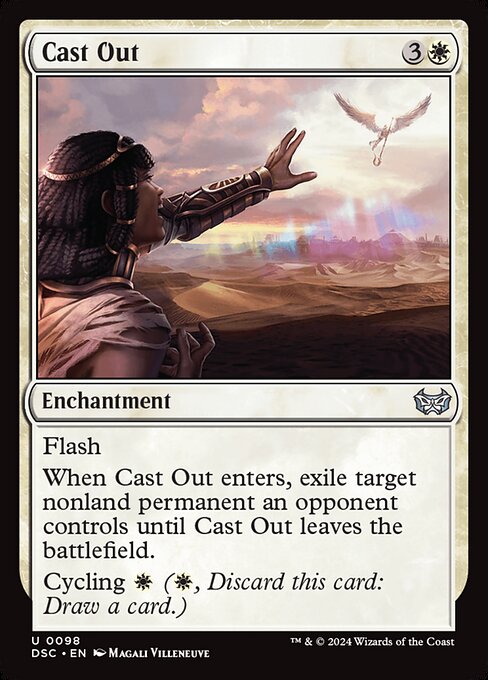
Image courtesy of Scryfall.com
Design Chaos and the Psychology of Casting Exile
White has long lived in MTG as the color of order, protection, and tempo control, but Cast Out crystallizes a particularly human truth: the appeal of a clean, decisive answer to a looming threat. This uncommon enchantment, a flash-play at a modest mana cost of {3}{W}, invites you to do something you’ve seen in countless real-world choices—respond immediately, then reframe the game space on your terms. When Cast Out enters, you exile a target nonland permanent an opponent controls until Cast Out leaves the battlefield. It’s the kind of effect that forces opponents to recalibrate, not just to lose a threat but to anticipate which threat you might pick next. And because it includes cycling for {W}, the card doubles as a late-game resource, turning tempo into card advantage when the board state cools down. 🧙♂️🔥
From a design perspective, Cast Out hits several sweet spots at once. First, the flash trigger creates a temporal microcosm: you answer a threat at instant speed, but you’ve also signaled to the table that you’re not playing by the standard “play a long-turn plan” tempo. Instead you’re weaving decisions in real time, which in practice means opponents must weigh their plays more carefully. Second, exile as a removal mode is elegantly simple and thematically fitting for white’s purview: exile is a clean, permanent-esque reset that doesn’t just destroy but relocates and restrains. Third, the “until this enchantment leaves the battlefield” clause makes Cast Out a symmetrical tempo engine—your own next turns heavily depend on Cast Out sticking around, which invites creative play patterns such as blink effects, reanimation shenanigans, or value-based recasting in ongoing Commander games. And the cycling adds a steady trickle of inevitability, letting you drift toward answers when the board becomes choked with threats. ⚔️
“A single instant can tilt the entire battlefield, and Cast Out flips the table by turning exile into a strategic tool that rewards precise timing and reading your opponents’ plans.”
The synergy of Flash with exile is especially telling in commander formats where group dynamics shape the pace. WhenCast Out resolves, you don’t just remove a problematic permanent; you also create a mental map of what your opponents can and cannot rely on in the next swing. This is where human behavior—the way players react to visible control, to chance cycles, to the dawning realization that a timer has quietly started—becomes a core part of the design conversation. If you’re piloting a white-heavy deck, Cast Out becomes a lens to observe how people recalibrate their threats and pacing based on a single, decisive moment. And if you’re the kind of player who enjoys the long-game view, the cycling clause offers a built-in avenue to stay in the game even when the board feels congested. 🧠💎
Let’s give some context to the card’s home in Duskmourn: House of Horror Commander. This set blends gothic atmosphere with the familiar Commander tempo, where familiar removal tools get a twist through flash and exile. Cast Out’s unsettlement factor—exiling another player’s threat then letting you redraw with cycling—also echoes the set’s cadence, where the line between control and chaos is blurred by theme and mechanics. Magali Villeneuve’s art on the card contributes to that mood, balancing elegance with a hint of menace, a reminder that white’s protective instincts can carry a noir edge when set against the right opponents. 🎨
In practice, Cast Out shines in meta games that prize tempo and interaction. It’s not a one-card answer to every problem, but in the right deck it acts as a reliable shield and a pressure point. The card’s rarity—uncommon—reflects a thoughtful balance: it’s potent and flexible, yet not so front-and-center that it crowds the strategy. The decision to include cycling means you’re never truly out of ideas; when the battlefield is crowded, a quick {W} to draw can reveal your next line of play, whether that’s another exile target, a white instant to protect, or a clever flicker combo that reinterprets what “leaves the battlefield” really means. This is design that asks players to adapt—and that meta-awareness, in turn, mirrors how actual humans respond to shifting rules, new threats, and the glittering lure of a well-timed advantage. 🧙♂️🎲
For fans who love the tactile, the visual, and the strategic in equal measure, Cast Out invites you to savor the moment when you decide to exile, flip the board state, and then Cycle into something even better. It’s a delicate dance between control and opportunity, and the psychology behind that dance is what makes this card so memorable. Whether you’re drafting a clever blink-bishop strategy, or simply savoring a crisp tempo play that leaves opponents guessing, Cast Out provides a perfect example of how a single enchantment can reveal broader truths about human behavior in competitive play. ⚡
On the practical side of fandom life, keeping track of your gear between rounds matters as much as your plays. If you’re looking for a stylish companion for your deck-building adventures, consider a practical carry solution that travels well—our sponsor’s Magsafe phone case with card holder is a neat fit for players on the go, offering both protection and a convenient place to stash a few notes or a spare token. Click the link below to learn more and grab yours while you’re at it.
Magsafe Phone Case with Card Holder – Glossy Matte PolycarbonateMore from our network
- https://blog.crypto-articles.xyz/blog/post/how-pokedex-entries-shape-grass-energy-card-design-in-tcg/
- https://blog.zero-static.xyz/blog/post/how-ai-driven-skyclave-plunder-combos-reshape-mtg-strategy/
- https://blog.digital-vault.xyz/blog/post/rarity-vs-usability-the-vaynes-treachery-paradox/
- https://blog.rusty-articles.xyz/blog/post/constraints-spark-red-white-tibor-and-lumia-decks/
- https://blog.digital-vault.xyz/blog/post/inside-the-inkrise-infiltrator-art-designer-mtg-collaboration/